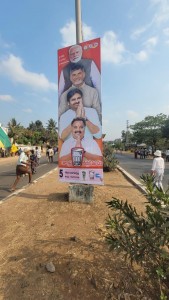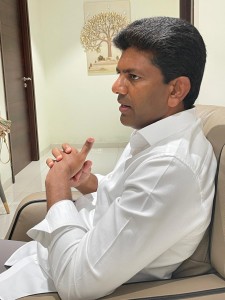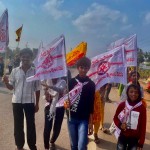Kovvali is a village in the West Godavari district of Andhra Pradesh, with an estimated population of 13,000. S.K. Basha, 14, studies in Class 9 at the Narayana School nearby. He speaks English with enthusiasm and fluency. Maths is his favourite subject, and he intends to study for the Indian Administrative Services exam, so that he can “help the poor to develop.” The Narayana schools in India are known for cultivating bright minds, and for their success in graduating their students into the engineering, medicine and civil services streams. It shows: young Basha spends his evenings with his father and grandfather, working on his science and maths, reading newspapers, and learning about the world. Of all the countries in the world, Basha is most curious about Israel, which he wants to visit to see how the war is being managed and to see the place where Christianity was born.
Despite his worldliness, Basha still has the village in him. He is cycling without his footwear, and when asked why, he says, “I am used to it and like it that way.”
Basha is part of an expanding tribe of young Indians who are determined, ambitious – and rooted in their geographies. They also want to serve their country in some form or the other. This desire to contribute is a running theme in today’s India, which is in the middle of national elections. Some of these aspirations were visible during an eight-day, four-state road journey in early May, through Andhra Pradesh, Telangana, Karnataka and Maharashtra. These are also in the most contested states of India, with new, untested alliances, where regional parties and opposition strongmen have deep roots, and a different agenda from Prime Minister Narendra Modi.
Over the last decade, Modi has put India on the road to an expected 7.4% growth this year, and made it the world’s fastest-growing large economy, fifth in the world. The impact is evident in India’s improved highways, a more educated, prosperous populace and a more assertive foreign policy.
Consequently, in the five years since the last national elections held in 2019, this has become a different India. Education improvements mean that 265 million Indians are now in school, and young Basha will be among the 43 million[1] who will enter college. According to the World Bank[2], there is a 108% enrolment in primary school (grade 6), 79% of Indians are enrolled for secondary education (classes 7-12) and a 32% enrolment in college. That means India is just 20% short of full literacy up to middle school, or age 14. In a very short time, India can achieve a developed country goal – the first time in India’s national and civilizational history that an entire generation will have had a basic education.
This is not yet as good as China, the only other comparable large-population economy, which has near-complete school literacy, but it shows India is on track to achieve these universal goals. With better education, the ruling BJP’s ongoing agenda of building skills and ensuring manufacturing can take root in India, and Prime Minister Modi’s goal of making India a developed economy by 2047, becomes achievable.
This election will decide that future. Even after 10 years in office, Modi is immensely popular across India, especially with women voters whose lives he has improved considerably with the various schemes that give women income, education, safety and dignity at home and outside of it. Youth are also part of this cohort of Indians looking long-term to the future.
But as with most human conditions that graduate upwards into improvement, the new status becomes the norm. Anything less is unacceptable. This is visible in India, especially during elections, where the next big improvement is demanded. Connectivity in India has improved dramatically. Digital connectivity is among the best in the world, and physical infrastructure is improving by the day. Roads in India are now as motorable as anywhere else internationally, thanks to the deployment of national highways by the Road Transport and highways ministry, run efficiently by Minister Nitin Gadkari. Consequently, state highways and sometimes municipal or village connector roads are decrepit in comparison, and occupy voter focus and discontent, even though they are not part of the national election mandate.
Some of the local and state dissatisfaction is evident in parts of Maharashtra, India’s most developed state. Apart from the state and local roads, voters are confused and hurt by the in-fighting within local political dynasties and the multiple party splits. Here, the election is most hotly fought between several parties – the ruling Bharatiya Janata Party (BJP), the Congress, the two units of the split Nationalist Congress Party and two of the split Shiv Sena, the Vanchit Bahujan Aghadi of Prakash Ambedkar, (grandson of Babasaheb Ambedkar the father of the Indian Constitution), the Republican Party of India, which are some of the larger ones.

The resultant vacuum of leadership and issues has been filled with many resentments, some related, some genuine and solvable, and some not. Manoj Jarange Patil, 41, is a local firebrand from Antarvali village near Ahmednagar. In 2023, he agitated for his Maratha community to be included in the quota system of a lower caste so they could get state jobs and pay less for higher education. His fast lasted for 17 days, drew 2.5 lakh followers and attracted national attention. The quota he demanded has not been granted, but Patil is confident it will, once the elections are over. He claims that the frequency of Modi’s campaign visits to Maharashtra this year accelerated because of the attention Patil drew to his cause. He acknowledges that his is a state issue, not a national one, and he will run on it in the upcoming state elections in October.

Onions are another local issue being force-fitted into the national narrative. India is the world’s largest producer of onions, and Maharashtra is India’s largest producer, especially of the red onion, whose pungency makes it a favourite export item, particularly to West Asia. In Maharashtra, the Lasalgaon onion influences prices. A drought in Maharashtra late last year led to lower production of red onions, and fearful of an onion shortage at home creating a crisis just before the elections, New Delhi directed exports to be stopped for better local availability. It infuriated the powerful Agriculture Producers Market Committee (APMC) of Lasalgaon, which complained that while neighbouring Gujarat could continue exporting its white onion, Maharashtra was prevented from making its annual export profit. The APMC has vowed to defeat Modi, who they accuse of partiality to his home state of Gujarat and will give their votes to the original faction of the Shiv Sena which, they feel, has also been wronged by Modi’s BJP.
Not all voters have such an emotional reaction to elections. In the southern state of Andhra Pradesh, which sends 25 representatives to the national parliament in Delhi, and is contesting state elections simultaneously, the two contesting parties present a clear choice: more welfare schemes or development and prospects for youth. The former is espoused by incumbent chief minister Jagan Mohan Reddy of the YCP, the latter by Chandrababu Naidu of the Telugu Desam Party (TDP) who as former chief minister of the undivided state of Andhra put its capital Hyderabad on the global technology map. After the state was divided into Telangana and Andhra in 2014, Telangana kept its jewel, Hyderabad, and is flourishing, Andhra Pradesh despite its capacities, has receded into the background. As the first chief minister of the bifurcated state, Naidu embarked on the building of a new capital city, Amravati, about 20 km from cultural capital Vijayawada, intended to rival Hyderabad. But the welfare schemes and easy annual payouts offered to voters by his competitor Jagan Reddy resulted in the loss of his seat – and the suspension of Amravati.

Andhra Pradesh has extraordinary talent, especially in engineering. Its people are also global. Of the 2.7 million Indian population in the U.S., 500,000 are Telegu-speaking from Andhra and Telangana[3]. They fill the tech industry, where Telegus are said to form the majority of engineers, andthe medical world. Indian-origin doctors represent 8.5% of the 100,000 medical practitioners in the U.S.;[4] of these, an estimated 10,000 are Telegu. [5]

The young in Andhra who grew up with memories of Hyderabad as Cyberabad with many high-quality jobs available for engineers, dreamed of Amravati fulfilling those aspirations – which never materialised. Now they are fervently hoping for a return of Naidu.
A young student in Vijayawada in the first year of his bachelor’s degree in technology, drives taxis at night to and from the airport, to augment the family income. Although many of his classmates thought of studying and applying for software jobs in the U.S., the layoffs in Silicon Valley this year – of which 10,000 alone are estimated to be Telegu H1B visa holders now heading home[6] – have made that journey less attractive. In fact, he does not even want to work in another Indian state.
His night gig isn’t all that helpful either: Vijayawada was an active second city in undivided Andhra with several direct flight connections in India. But now it has direct flights to only four cities in India – eight from nearby Hyderabad, six from Bangalore, two from Chennai, and two from Delhi. Compare it to Hyderabad, which has between one and two dozen direct daily flights from all of India’s top cities, at least four to India’s second-tier cities and at least two a day to several international destinations between Muscat and Singapore. The student wants Amravati and his pride revived and his vote is going to TDP’s Naidu, who has an alliance with the BJP.
Successful doctors and entrepreneurs from the U.S. have similar feelings, and at least one has returned to the state to run for election. P. Chandrasekhar is a successful physician and entrepreneur who has come back to India after 24 years in California; he is the richest candidate in this election, with declared assets of Rs. 5,705 crores. “I’m done making money,” says the first-time politician, speaking from his new home in Vijayawada on why he has jumped into the fray. “My home state has issues, and long term, India has issues. Systems are not working as they should, there is corruption and too much money in politics for a good person with ideas to enter.” He is running from the prosperous Guntur constituency on a TDP-BJP ticket. He wants to introduce what he considers to be some successful elements of the U.S. system like the jury system, and especially intends to follow up on Naidu’s main campaign plank of correct titling of land – a sensitive subject across India – in addition to addressing issues of water, roads, bridges, drainage, quality hospitals. Welfare is necessary, he says, but so is industrialisation and the generation of income.
Chandrasekhar’s was a rare voice in India’s political landscape, who spoke of income generation, wealth creation, and raising revenue for his state. Most states and their leaders especially those from India’s socialist-era parties, don’t do the hard work of funding their own state plans and activities. Instead, they rely on central government tax-sharing and funds, making them reliant on New Delhi – and in this case, Prime Minister Modi’s government. State funds are being used for elaborate welfare schemes, which when pooled together provide enough money for a family per day – and disincentivise business or hard work.

It’s all about the money – earned, extracted or disbursed by wealthy politicians are common. Several of them, from the dynamic new chief minister of Telangana Revanth Reddy, to stalwart politicians in Maharashtra like Chhagan Bhujbal and Sharad Pawar, and Andhra’s Jagan Reddy, are comfortably ensconced in palatial homes with farmhouses and expensive 4x4s – which did not come from state funds or from their families’ modest beginnings as agriculturists. There are few like Naveen Patnaik, the chief minister of Odisha who had a privileged background, or civil aviation minister Jyotiraditya Scindia whose royal antecedent provides a strong monetary cushion.
Indians are tolerant of such faults. The country’s remarkable digital infrastructure has already made most Indians equal in terms of access to services and to government. What matters now is achieving the dream of a good life through quality education, quality health and quality physical infrastructure, especially last-mile connectivity. The candidates and parties that can provide it, will find themselves riding high on the ballot come June 4.
Manjeet Kripalani is Executive Director, Gateway House.
This blog was exclusively written for Gateway House: Indian Council on Global Relations. You can read more exclusive content here.
Support our work here.
For permission to republish, please contact outreach@gatewayhouse.in.
©Copyright 2024 Gateway House: Indian Council on Global Relations. All rights reserved. Any unauthorised copying or reproduction is strictly prohibited.
References
[1] “Prime Minister Addresses the Inaugural Session of the 16th Pravasi Bharatiya Divas Convention.” Press Information Bureau of India, January 9, 2021.
https://pib.gov.in/PressReleaseIframePage.aspx?PRID=1999713
[2] “Primary Completion Rate (% of Relevant Age Group).” World Bank Gender Data Portal. Accessed May 31, 2024.
https://genderdata.worldbank.org/en/indicator/se-prm-cmpt-zs.
[3] U.S. Census Bureau. “The Asian Population: 2020.” American Community Survey Reports, ACS50.
https://www.census.gov/content/dam/Census/library/publications/2022/acs/acs-50.pdf
[4] “About AAPI.” Asian American and Pacific Islander (AAPI) Civic Engagement Fund.
https://aapiusa.org/about-aapi/
[5] “Six Telugu Doctors Made Big in AAPI, a Global Body of About One Lakh Plus Indian Doctors Based in the USA.” Telugu Times.
[6] Bhaskar Basava. “End of American Dream: Over 10,000 Telugu Software Professionals Lose Jobs.” NewsMeter


